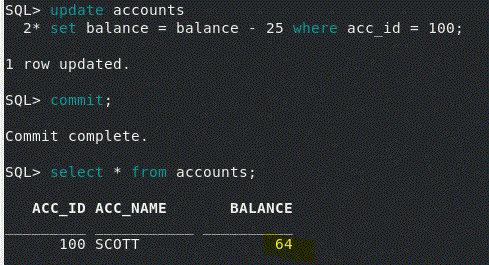- Overview:
- Oracle database allows DML statements to be executed in parallel mode by breaking the DML statements into exclusive smaller tasks.
- However in releases prior Oracle database 23ai, parallel DML operations had a limitation. Once an object is modified by a parallel DML statement, that object cannot be read or modified by later statements of the same transaction before ending the transaction by executing commit or rollback.
- Oracle Database 23ai removes that restriction and by introducing "Unrestricted Parallel DMLs or Unrestricted Direct Loads" feature.
- Benefits:
- In the same transaction session and before ending the transaction, you can:
- Query the same table multiple times
- Perform serial or parallel DML on the same table
- Perform multiple direct loads
- Overhead Reduced
- Enable parallel DML in a session
- Separate commits are not required after each parallel DML statement
- Take the full advantage of using parallel DMLs in the same transaction
- Heap organized table only.
- No ASSM tablespaces
- The parallel DML mode is required because parallel DML and serial DML have different locking, transaction, and disk space requirements and parallel DML is disabled for a session by default.
- When parallel DML is disabled, no DML is executed in parallel even if the PARALLEL hint is used.
- When parallel DML is enabled in a session, all DML statements in this session are considered for parallel execution.
- Run below SQL statement to enable parallel DML mode in a session:
ALTER SESSION ENABLE PARALLEL DML;
- Enable unrestricted parallel DML mode in a specific SQL statement, include the ENABLE_PARALLEL_DML hint.
INSERT /*+ ENABLE_PARALLEL_DML */ …
- However, even if parallel DML is enabled, the DML operation may still execute serially if there are no parallel hints or no tables with a parallel attribute or if restrictions on parallel operations are violated.
- In this practice, I'll enable parallel DML and perform a parallel insert (non-unrestricted) without commit or rollback. After the insert, I'll run a select from the same table and it will cause an error.
- Then I'll perform the parallel insert using unrestricted parallel hint without commit or rollback, After I'll run select and additional insert without errors.
|
SQL> create table
test_dmls as select * from objects_objects; Table
TEST_DMLS created. |
|
SQL> alter session enable
parallel dml; Session
altered. |
|
SQL> insert /*+
parallel(test_dmls 4) */ into test_dmls select /*+ parallel(test_dmls 4) */ * from test_dmls; 76,237 rows inserted. |
|
SQL> select count(*) from
test_dmls; Error
starting at line : 1 in command - select
count(*) from test_dmls SQL ORA-12838:
cannot read/modify an object after modifying it in parallel More
Details : https://docs.oracle.com/error-help/db/ora-12838/ SQL> !oerr ora 12838 12838, 00000, "cannot read/modify an object after modifying it in parallel" // *Cause: Within the same transaction, an attempt was made to add read or // modification statements on a table after it had been modified in parallel // or with direct load. This is not permitted. // *Action: Rewrite the transaction, or break it up into two transactions: // one containing the initial modification and the second containing the // parallel modification operation. |
|
SQL> commit; Commit
complete. |
|
SQL> select count(*) from
test_dmls; COUNT(*) ___________
152474 |
|
SQL> insert /*+
enable_parallel_dml(test_dmls 4) */ into test_dmls select /*+ enable_parallel_dml(test_dmls 4)
*/ * from test_dmls; 152,474
rows inserted. |
|
SQL> select count(*) from
test_dmls; COUNT(*) ___________
304948 |
|
SQL> insert /*+
enable_parallel_dml(test_dmls 4) */ into test_dmls 2* select /*+ enable_parallel_dml(test_dmls
4) */ * from test_dmls; 304,948
rows inserted. SQL>
/ 609,896
rows inserted. SQL>
/ 1,219,792
rows inserted. SQL> select count(*) from test_dmls; COUNT(*) ___________ 2439584 |





















